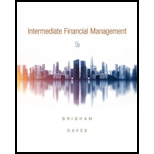
Intermediate Financial Management (MindTap Course List)
13th Edition
ISBN: 9781337395083
Author: Eugene F. Brigham, Phillip R. Daves
Publisher: Cengage Learning
expand_more
expand_more
format_list_bulleted
Textbook Question
Chapter 3, Problem 2Q
Security A has an expected
Expert Solution & Answer
Summary Introduction
To discuss: The security that is much riskier.
Explanation of Solution
In case of diversified portfolio due to lower negative correlation and beta with the other stocks, security A will be mess risky. However, in a single-asset portfolio, due to σA > σB and CVA > CVB, security A will be much risky.
Want to see more full solutions like this?
Subscribe now to access step-by-step solutions to millions of textbook problems written by subject matter experts!
Students have asked these similar questions
You invest $5,000 for 3 years at an annual interest rate of 6%. The interest is compounded annually. Need help
What is the future value of $500 invested for 3 years at an annual compound interest rate of 4%? Expl
You invest $5,000 for 3 years at an annual interest rate of 6%. The interest is compounded annually.
Chapter 3 Solutions
Intermediate Financial Management (MindTap Course List)
Ch. 3 - Security A has an expected rate of return of 6%, a...Ch. 3 - The standard deviation of stock returns for Stock...Ch. 3 - APT
An analyst has modeled the stock of Crisp...Ch. 3 - Two-Asset Portfolio
Stock A has an expected return...Ch. 3 - Prob. 4PCh. 3 - You have been hired at the investment firm of...Ch. 3 - You have been hired at the investment firm of...Ch. 3 - You have been hired at the investment firm of...Ch. 3 - You have been hired at the investment firm of...Ch. 3 - You have been hired at the investment firm of...
Knowledge Booster
Learn more about
Need a deep-dive on the concept behind this application? Look no further. Learn more about this topic, finance and related others by exploring similar questions and additional content below.Similar questions
- What is the future value of $500 invested for 3 years at an annual compound interest rate of 4%?arrow_forwardA loan of $10,000 is taken at an annual interest rate of 6% for 5 years. What is the total interest payable under simple interest? Expalarrow_forwardA loan of $10,000 is taken at an annual interest rate of 6% for 5 years. What is the total interest payable under simple interest?arrow_forward
- You borrow $8,000 at an annual interest rate of 7%, and it compounds yearly for 2 years. What is the total amount payable? Helparrow_forwardYou borrow $8,000 at an annual interest rate of 7%, and it compounds yearly for 2 years. What is the total amount payable?arrow_forwardIf a bond pays $50 annually and is priced at $1,000, what is its annual yield? Explarrow_forward
- If a bond pays $50 annually and is priced at $1,000, what is its annual yield?arrow_forwardA car loan of $15,000 is taken for 3 years at an annual interest rate of 8%. What is the simple interest payable?arrow_forwardYou gave me unhelpful so i am also gave you unhelpful.if you will not give unhelpful then also i will not give unhelpful. what is finance?arrow_forward
- You want to save $15,000 in 5 years. If your bank offers 3% annual interest, how much should you invest today? (Use compound interest.) Explarrow_forwardIf you invest $2,000 at an annual interest rate of 6%, compounded annually, for 3 years, what is the future value?arrow_forwardYou want to save $15,000 in 5 years. If your bank offers 3% annual interest, how much should you invest today? (Use compound interest.)arrow_forward
arrow_back_ios
SEE MORE QUESTIONS
arrow_forward_ios
Recommended textbooks for you
 Intermediate Financial Management (MindTap Course...FinanceISBN:9781337395083Author:Eugene F. Brigham, Phillip R. DavesPublisher:Cengage Learning
Intermediate Financial Management (MindTap Course...FinanceISBN:9781337395083Author:Eugene F. Brigham, Phillip R. DavesPublisher:Cengage Learning

Intermediate Financial Management (MindTap Course...
Finance
ISBN:9781337395083
Author:Eugene F. Brigham, Phillip R. Daves
Publisher:Cengage Learning
Internal Rate of Return (IRR); Author: The Finance Storyteller;https://www.youtube.com/watch?v=aS8XHZ6NM3U;License: Standard Youtube License